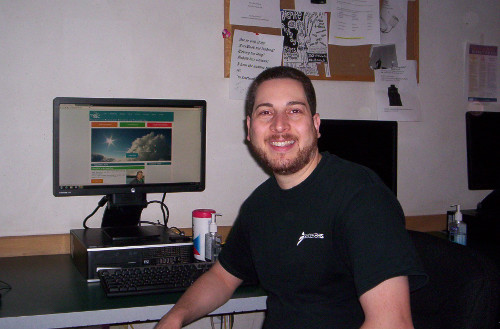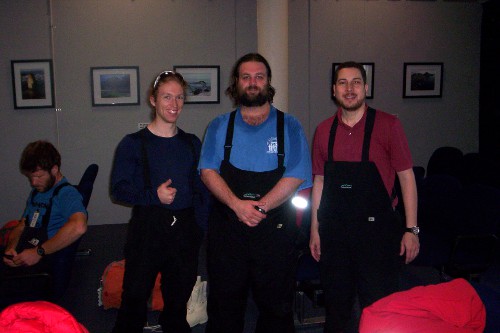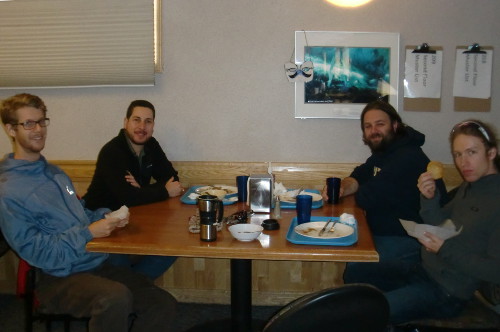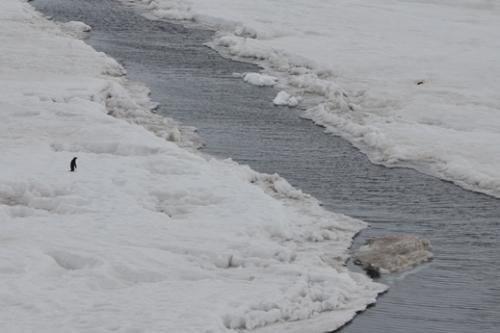It seems like we will stay for a couple of days here at McMurdo Station on the coast of Antarctica. McMurdo is the largest of three permanent United States stations in Antarctica, with about 1,000 people working at once every summer. There is also Palmer Station in the Antarctic Peninsula—which is supplied from Chile—and the Amundsen-Scott Station at the South Pole, where the IceCube NeutrinoAn elementary particle with zero charge and zero mass. An electrically neutral particle that is often emitted in the process of radioactive decay of nuclei. Neutrinos are difficult to detect, and their existence was postulated twenty years before the first one was actually discovered in the laboratory. Millions of neutrinos produced by nuclear reactions in the sun pass through your body every second without disturbing any atoms. ObservatoryA location used for observing terrestrial and/or celestial events. is located and where I am headed likely tomorrow. Since McMurdo Station is located about three-fourths of the way from New Zealand to the geographic South Pole, anyone traveling there will stop first at McMurdo for a day or two.

Our flight to the South Pole has already been cancelled two times, and even though we are looking forward to our final destination, we are fine here. We reported to transport both at 3:15 pm and 4:15 pm, but to no avail. Travel in Antarctica depends strongly on external factors such as weather, so plans and schedules have to be flexible. While a regular person would start getting uneasy about losing a flight, for us this is actually part of the fun, and we even like it that way. That is a requirement for people traveling to Antarctica: to see the brighter side of things, and take and enjoy things as they come. Since the beginning I knew it would be like this, so I was prepared for the challenge. I also recall the words from my mentor, Dr. James M. Madsen, early on in the project, to be ready and prepared for the unexpected.

I had previously told about two other members of IceCube before, so I will take a moment to introduce them formally. They are Hans Niederhausen from Stony Brook in New York, and James Casey from the Georgia Institute of Technology. Hans has deployed to the ice to install an all-sky camera, while James will do some calibration work at the IceCube Lab.

Our stay in McMurdo has been first class, and I cannot put it any other way. Awesome in every sense. The station is large, modern and well equipped, with comfortable living quarters and good food. Today they had a Mexican buffet and I finally had my Mexican fix. We have had lots of time to walk around, and even get some rest, which was good, as my last full 8-hour night had been December 31st!

Today we also experienced some –4 to –1 °C (30 to 25 °F) weather combined with like 100 km/hr (60 miles per hour) winds at Scott's hut here in McMurdo. This combination yielded a very strong windchill, which was quite amazing. Now I see what the poor Scott had to endure on those last days of his return trip. I have read the story like a million times, and knew all the facts, and had also learned about the area and the climate patterns there. But now I've got a real life experience that puts everything into perspective and allows a better appreciation of everything I had read so far.
We also got to see a penguin! What we saw was an Adélie penguin (Pygoscelis adeliae), which we found while hiking at Hut Point, just outside of McMurdo. There will be no penguins at our intended destination (i.e., the South Pole), so I feel this sighting has been one of the highlights of my stay here.

We will report again to transport tomorrow (Thursday, January 8) at 7:15 am as we might finally catch our plane to the South Pole. Naturally I am looking forward to my arrival at the IceCube Lab! That is the ultimate, definitive goal.
Tal parece que nos quedaremos un par de días más aquí, en la estación McMurdo de la costa antáctica. Esta es la mayor de las tres estaciones permanentes establecidas en el continente por los Estados Unidos, con aproximadamente unas mil personas trabajando concurrentemente cada verano. Existe también la estación Palmer en la península Antártica (cuya logística se maneja desde Chile) además de la estación Amundsen-Scott en el polo sur, lugar donde ubica el Observatorio de Neutrinos IceCube y a donde viajaré probablemente mañana. Por la estación McMurdo tiene que pasar todo el que se dirige al polo sur, dado que la misma queda exactamente en el camino (como a tres cuartas partes) entre Nueva Zelandia y el polo sur geográfico.

El vuelo para el polo sur nos lo han pospuesto ya dos veces. Pero aun con el deseo y excitación que sentimos por llegar al polo, aquí hemos estado muy bien. Nos presentamos al departamento de transporte a las 3:15 pm y luego a las 4:15 pm, pero sin resultado alguno. En realidad, los trabajos en el continente antártico dependen en buena medida de factores como el estado del tiempo, cosas que uno no puede controlar. Por eso todo proyecto tiene que ser flexible e incluso contemplar otras opciones. Aunque una persona corriente quizás se molestaría con tanto retraso, nosotros no lo vemos así e incluso nos parece interesante. Sencillamente estas cosas son parte de la diversión. Quien emprende un viaje a la Antártida tiene que tomar las circunstancias como se presenten y aprender a manejarlas de buena gana. Desde el comienzo supe que así serían las cosas y me preparé para el reto. Recuerdo especialmente las palabras de mi mentor, el doctor James M. Madsen, quien al comienzo del proyecto me dijo, "prepárate para ver cámbios súbitos de planes".

Había mencionado anteriormente a otros dos miembros del IceCube, así que pasaré a explicar quiénes son. Se trata de Hans Niederhausen de la universidad de Stony Brook en Nueva York, y de James Casey del Instituto de Tecnología de Georgia. Hans ha llegado para instalar una cámara para captar el cielo completo mientras que James se dedicará a hacer trabajos de calibración con el IceCube.

Nuestra estadía en McMurdo ha sido de primera categoría y no podemos quejarnos de nada. Excelente en todos los aspectos. La estación es amplia, moderna y está bien abastecida de todo. Los alojamientos son cómodos y la comida magnífica. Hoy sirvieron un bufé mexicano y nos dimos gusto. Hemos tenido la oportunidad de recorrer los alrededores y hasta ha sobrado tiempo para descansar. Esto ha sido fabuloso, pues la última noche en que disfruté ocho horas de sueño fue el pasado 31 de diciembre.

También hoy, durante nuestra visita a la cabaña de Scott, tuvimos temperaturas de –4 a –1 °C (30 a 25 °F) con vientos de 100 km/hr (60 millas por hora). Esta combinación produjo un efecto 'windchill' muy fuerte que nos dejó asombrados. Ahora comprendo las penurias que tuvo que pasar el capitán Scott durante sus últimos días, a su regreso del polo sur. La historia la había leído muchas veces, y he leído también sobre el lugar y los patrones del clima. Pero después de esta experiencia vivida todo adquiere una nueva perspectiva, y el entendimiento es más amplio y completo que lo provisto por cualquier lectura.
¡Además, hemos visto un pingüino! Se trataba de un pingüino adelaida (Pygoscelis adeliae), el cual avistamos desde punta Hut, justamente afuera de McMurdo. Como en el polo sur no existen pingüinos, creo que este avistamiento es de lo mejor que nos ha ocurrido durante nuestra estadía aquí.

Retornaremos mañana (jueves, 8 de enero) a las 7:15 am al departamento de transporte para ver si finalmente podemos tomar nuestro vuelo al polo sur. Naturalmente estoy deseoso de llegar al observatorio de neutrinos IceCube! Esa es la meta definitiva.


Comments